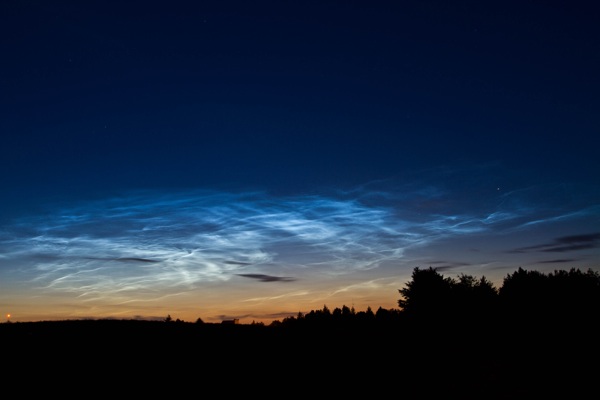
While still very rare, spectacular night-shining clouds, aka noctilucent clouds, are becoming more common and increasingly brighter, according to a NASA atmospheric scientist. Noctilucent clouds are the highest in Earth's atmosphere, forming from water ice at altitudes of 76 to 85 kilometers. NASA's Matthew DeLand suggests that their increased visibility could be linked to greenhouse gases. From Space.com:
Night-shining clouds are extremely sensitive to changes in atmospheric water vapor and temperature. The clouds form only when temperatures drop below minus 200 degrees Fahrenheit (minus 130 degrees Celsius), when the scant amount of water high in the atmosphere freezes into ice clouds. This happens most often in far northern and southern latitudes (above 50 degrees) in the summer when, counter-intuitively, the mesosphere is coldest. Changes in temperature or humidity in the mesosphere make the clouds brighter and more frequent. Colder temperatures allow more water to freeze, while an increase in water vapor allows more ice clouds to form. Increased water vapor also leads to the formation of larger ice particles that reflect more light.
The fact that night-shining clouds are getting brighter suggests that the mesosphere is getting colder and more humid, DeLand said. Increasing greenhouse gases in the atmosphere could account for both phenomena.
 While still very rare, spectacular night-shining clouds, aka noctilucent clouds, are becoming more common and increasingly brighter, according to a NASA atmospheric scientist. Noctilucent clouds are the highest in Earth's atmosphere, forming from water ice at altitudes of 76 to 85 kilometers. NASA's Matthew DeLand suggests that their increased visibility could be linked to greenhouse gases. From Space.com:
While still very rare, spectacular night-shining clouds, aka noctilucent clouds, are becoming more common and increasingly brighter, according to a NASA atmospheric scientist. Noctilucent clouds are the highest in Earth's atmosphere, forming from water ice at altitudes of 76 to 85 kilometers. NASA's Matthew DeLand suggests that their increased visibility could be linked to greenhouse gases. From Space.com: 
No comments:
Post a Comment